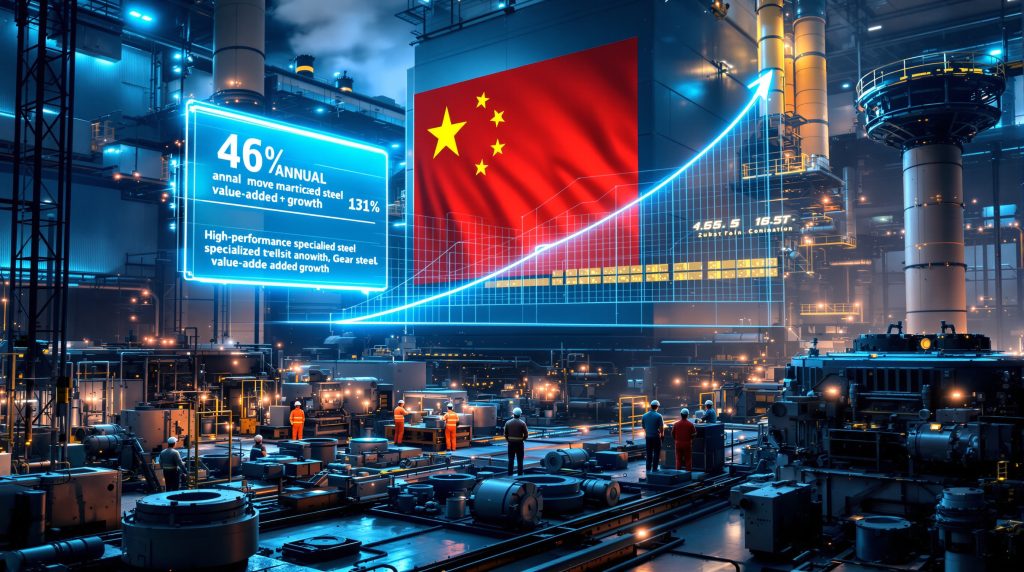China's Steel Transformation: 2025-2026 Growth Strategy
China's newly unveiled steel industry growth plan for 2025-2026 represents a strategic shift from quantity to quality in the world's largest steel market. The plan, jointly issued by five key ministries including the Ministry of Industry and Information Technology (MIIT), targets approximately 4% annual value-added growth while implementing comprehensive measures to address overcapacity, enhance profitability, and accelerate green transformation.
This strategic initiative emerges at a critical time for China's steel sector, which currently accounts for over 50% of global steel production but faces significant profitability pressures amid weakening traditional demand drivers.
Core Objectives of the Growth Strategy
- Achieve balanced market supply and demand conditions
- Optimize industrial structure through technological advancement
- Improve quality and efficiency across the steel supply chain
- Develop "new quality productivity" tailored to regional conditions
- Break the industry's historical dependence on scale expansion
Current Market Context and Challenges
- Steel sector experiencing significant profitability pressures
- Industry profits declined 42.6% year-on-year to ¥66.3 billion ($9.3 billion) in 2024
- Partial recovery to ¥83 billion in first seven months of 2025, but remains fragile
- Traditional demand drivers (property and infrastructure) showing continued weakness
- Manufacturing sectors providing insufficient demand to offset construction declines
- Growing international trade tensions creating export uncertainties
How Will China Control Steel Capacity and Production?
The plan establishes a comprehensive framework for managing China's massive steel production capacity, which currently accounts for over half of global output. This represents Beijing's most determined effort yet to address long-standing issues of overcapacity and low-quality production.
New Three-Tier Classification System
- Top tier: Advanced, efficient producers receiving preferential resource allocation
- Middle tier: Standard compliant facilities facing gradual transformation requirements
- Bottom tier: Outdated, inefficient operations targeted for accelerated elimination
This classification system marks a significant departure from previous approaches by creating a clear roadmap for capacity rationalization rather than implementing broad production cuts.
Production Control Mechanisms
- No approval for new steel production capacity
- Strict enforcement of production cuts for inefficient facilities
- Phased elimination of outdated equipment including:
- Aging blast furnaces
- Obsolete converters
- Outdated coke ovens and sintering machines
- Annual production targets established to support advanced enterprises
- Forced exit of backward and inefficient production capacity
Industry experts note this approach represents a more sophisticated strategy than previous capacity reduction efforts, as it targets specific facility types rather than imposing blanket restrictions.
Technology Transition Priorities
- Accelerated development of electric arc furnace (EAF) steelmaking
- Support for hydrogen metallurgy research and implementation
- Removal of long steelmaking processes (blast furnace-converter route)
- Development of short-process EAF routes in suitable regions
The plan specifically endorses the transition from traditional blast furnace routes to more flexible and environmentally friendly electric arc furnace technology, acknowledging regional variations in implementation feasibility.
What Environmental Targets Does the Plan Include?
Environmental transformation stands as a cornerstone of China's steel industry strategy, with specific targets and implementation mechanisms designed to align the sector with national climate goals.
Ultra-Low Emissions Standards
- More than 80% of steel capacity to complete ultra-low emissions upgrades by end-2025
- First-time inclusion of steel industry in China's national carbon emissions trading scheme
- Establishment of digital energy and carbon management centers by enterprises
- Accelerated development of carbon footprint accounting standards for steel products
The 80% ultra-low emissions target represents an ambitious acceleration of environmental compliance in an industry that has historically been one of China's largest polluters.
Green Technology Advancement
- Promotion of hydrogen metallurgy and clean energy substitution
- Enhanced carbon measurement management systems
- Improved quality of carbon accounting data
- Preparation for carbon quota trading after market integration
The plan's focus on hydrogen-based steelmaking signals China's long-term commitment to exploring alternatives to coal-dependent production, though implementation timelines remain flexible.
Resource Efficiency Improvements
- Integrated recycling hubs in scrap-rich regions
- Optimized material flows across the production chain
- Enhanced energy efficiency in steelmaking processes
- Smart factory technologies to reduce resource consumption
By establishing recycling centers in regions with abundant scrap resources, the plan aims to strengthen domestic material security while reducing the environmental impact of primary steelmaking.
How Will the Plan Affect Steel Raw Materials?
The growth strategy addresses critical raw material concerns through a multi-faceted approach aimed at stabilizing supply and prices, particularly important given China's high import dependency for key inputs.
Iron Ore Strategy
- Support for domestic iron ore project development
- Protection for compliant mining operations
- Avoidance of one-size-fits-all regulatory approaches
- Enhanced industry regulation with flexibility for efficient producers
While China remains heavily dependent on imported iron ore, the plan aims to optimize domestic production while avoiding counterproductive restrictions on efficient operations. Current iron ore price forecasts suggest continued volatility as markets adapt to China's evolving steel strategy.
Coking Coal and Scrap Management
- Encouragement of long-term supply contracts for coking coal
- Support for high-quality coal imports to ensure quality standards
- Development of comprehensive scrap steel collection networks
- Construction of integrated recycling facilities in key regions
The emphasis on long-term contracts for coking coal represents an effort to reduce price volatility in this critical input, while the scrap collection strategy aims to decrease reliance on primary raw materials.
Supply Chain Security Measures
- Strengthened resource security through diversification
- Reduced dependence on volatile international markets
- Enhanced quality control mechanisms for raw inputs
- Strategic reserves management for critical materials
These measures reflect growing concerns about supply chain resilience in an increasingly uncertain global trade environment, with particular attention to the critical materials supply chain where China faces significant import dependency.
What High-End Materials Will China Prioritize?
The plan emphasizes development of specialized steel products to move up the value chain and reduce reliance on imports, targeting specific high-value segments.
Priority High-Performance Steel Categories
- Bearing steel for precision machinery applications
- Gear steel for automotive and industrial equipment
- High-temperature alloys for aerospace and energy sectors
- Specialized steels for nuclear, marine, and defense applications
These categories represent areas where China currently depends on imports or where domestic production quality lags behind international standards, creating strategic vulnerabilities.
R&D Collaboration Framework
- Joint research initiatives between steel producers and downstream industries
- Partnerships with academic and research institutions
- Coordinated technology roadmaps for critical applications
- Accelerated commercialization pathways for innovative materials
The collaborative approach acknowledges that developing high-end steel products requires close coordination between producers and end-users to meet specific performance requirements.
Quality Certification Systems
- Expanded certification for low-carbon steel products
- Enhanced traceability for key construction materials like rebar
- Higher standards for automotive, machinery, and appliance steel
- Quality verification systems aligned with international benchmarks
By strengthening quality assurance mechanisms, the plan aims to address persistent concerns about inconsistent quality in Chinese steel products, which has limited their acceptance in premium applications.
How Will China Balance Domestic and International Markets?
The plan outlines a coordinated approach to domestic consumption and export management, reflecting growing awareness of international trade tensions.
Domestic Market Development
- Promotion of steel use in housing, public buildings, and infrastructure
- Enhanced cooperation across construction supply chains
- Deeper partnerships with shipbuilding and transportation sectors
- Industry association coordination to stimulate new applications
Despite weakening traditional demand drivers, the plan identifies specific sectors where steel consumption can be maintained or expanded through targeted promotion efforts.
Export Management Strategy
- Tightened oversight of steel exports to maintain market order
- Optimization of exported product structures toward higher value
- Alignment with global standards for product quality
- Development of carbon footprint measurement systems compatible with international frameworks
The focus on export management acknowledges growing tariff market impacts and the need to shift China's steel exports away from low-value commodities toward higher-value specialty products.
Belt and Road Initiative Integration
- Encouragement for Chinese firms to expand cooperation with BRI markets
- Technology and service exports alongside products
- Development of international standards harmonization
- Strategic positioning in emerging market supply chains
The Belt and Road Initiative continues to be viewed as a strategic channel for Chinese steel producers to expand international presence, particularly as traditional export markets become more restricted.
What Digital and Smart Manufacturing Elements Are Included?
The plan accelerates China's push toward digitalization and intelligent manufacturing in the steel sector, recognizing the transformative potential of Industry 4.0 technologies.
Smart Factory Development
- Accelerated renewal of aging production equipment
- Implementation of AI-driven process optimization
- Development of integrated digital control systems
- Enhanced predictive maintenance capabilities
The emphasis on upgrading aging equipment acknowledges that China's steel industry includes many outdated facilities that cannot achieve efficiency and quality targets without substantial modernization.
Digital Supply Chain Integration
- Construction of digital platforms connecting producers and consumers
- Real-time inventory and logistics management systems
- Enhanced market intelligence and forecasting capabilities
- Streamlined procurement and distribution networks
These digital supply chain initiatives aim to reduce inefficiencies and improve responsiveness to market changes in an industry traditionally characterized by information asymmetries.
Industry 4.0 Technologies
- Industrial Internet of Things (IIoT) implementation
- Big data analytics for production optimization
- Cloud computing infrastructure for industry coordination
- Cybersecurity frameworks for critical industrial systems
The adoption of advanced digital technologies is positioned as essential for achieving the plan's quality and efficiency objectives, though implementation challenges remain significant. These efforts align with broader industry transformation trends occurring across the metals and mining sectors.
What Financial Support Will Be Available?
While not explicitly detailed in the announcement, the plan is expected to be supported by various financial mechanisms to enable the substantial investments required.
Potential Funding Sources
- Ultra-long-term government bonds for technological upgrades
- Green finance initiatives for environmental improvements
- Preferential lending for strategic modernization projects
- Tax incentives for research and development activities
Industry observers note that the scale of transformation envisioned in the plan will require significant financial resources, particularly for smaller producers with limited access to capital markets.
Investment Priorities
- Environmental compliance and emissions reduction
- Energy efficiency improvements
- Advanced process technologies
- High-value product development
These investment priorities reflect the plan's emphasis on quality over quantity, with financial support likely to be concentrated on initiatives that advance strategic objectives rather than capacity expansion. These priorities also align with broader mining decarbonisation trends that are reshaping the global industry.
What Market Impact Has the Plan Had So Far?
Initial market reaction to the plan announcement has been muted, with several factors contributing to the restrained response.
Price Performance
- Futures prices for finished steel (rebar and HRC) ended mixed following the announcement
- Key steelmaking raw materials (coke, coking coal, and iron ore) showed limited price movement
- Absence of specific production targets created uncertainty about supply implications
The mixed price reaction reflects market uncertainty about implementation details and timing, particularly regarding production volumes.
Industry Perspectives
- Market participants noted the lack of detailed steel production targets for 2025-2026
- Ambiguity around the definition of "value added" growth created interpretation challenges
- Continuation of previous policy directions rather than radical new approaches
As noted by one Chinese steel trader cited by Fastmarkets, "The definition of value added is not clear. It didn't specify output or steel price," highlighting the challenge of translating policy statements into market expectations.
FAQs About China's Steel Growth Plan
How does the 2025-2026 plan differ from previous steel industry policies?
The new plan maintains similar growth targets to previous years (about 4% annual value-added growth compared to over 4% for 2024 and about 3.5% for 2023) but places significantly stronger emphasis on quality improvement, environmental compliance, and technological advancement rather than production volume. It also introduces a more structured classification system for steel producers and establishes clearer pathways for capacity rationalization.
Will the plan succeed in addressing China's steel overcapacity issues?
The plan represents China's most comprehensive effort to date to tackle structural overcapacity, with specific mechanisms for eliminating inefficient facilities and preventing new capacity additions. However, implementation challenges remain, particularly regarding local government incentives and the social impacts of capacity reduction. Success will depend largely on enforcement consistency and the availability of financial support for technological transformation.
How might the plan affect global steel markets?
While the plan aims to stabilize China's domestic steel market, its export management provisions could significantly impact global trade flows. By optimizing export product structures and aligning with international standards, Chinese exports may shift toward higher-value products while potentially reducing volume in some commodity-grade segments. This could provide breathing room for producers in other regions while increasing competition in specialty steel categories.
What role will hydrogen play in China's steel decarbonization?
The plan explicitly encourages hydrogen metallurgy development as part of China's long-term steel decarbonization strategy. While large-scale hydrogen-based steelmaking remains economically challenging in the near term, the policy signals growing investment in this technology pathway after 2025, potentially accelerating cost reductions and commercial viability for green hydrogen applications in steelmaking.
Conclusion: Strategic Significance of China's Steel Plan
China's 2025-2026 steel growth plan represents a pivotal moment in the evolution of the world's largest steel industry. By prioritizing quality over quantity, environmental performance over production volume, and technological advancement over capacity expansion, the plan signals a fundamental shift in China's industrial strategy.
The success of this transformation will have profound implications not only for China's economic development and environmental goals but also for global steel markets, raw material demand, and industrial decarbonization pathways. As implementation unfolds over the coming years, the plan's effectiveness will be measured by its ability to restore industry profitability, advance technological innovation, and align China's steel sector with the country's broader economic and environmental objectives.
Further Exploration:
Readers interested in learning more about developments in China's steel industry can explore related educational content available from Fastmarkets, which offers market analysis on global steel and raw materials markets, and China's official government announcement of the new steel industry work plan.
Ready to Invest in the Next Major Mineral Discovery?
Take advantage of Discovery Alert's proprietary Discovery IQ model that delivers instant notifications on significant ASX mineral discoveries, turning complex data into actionable insights. Understand why historic discoveries can generate substantial returns by visiting Discovery Alert's dedicated discoveries page and begin your 30-day free trial today.




